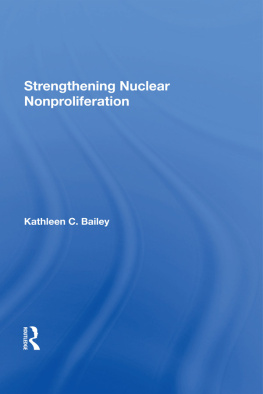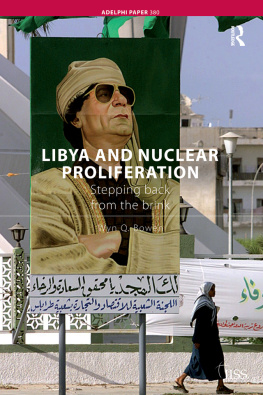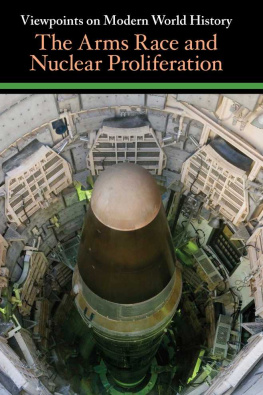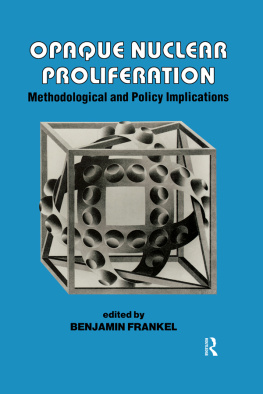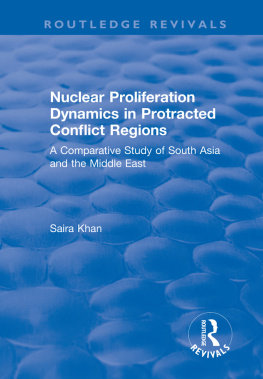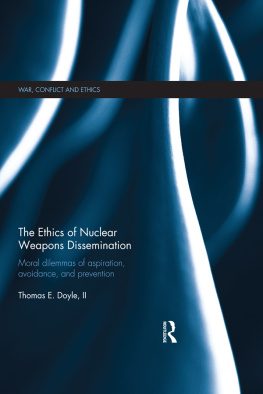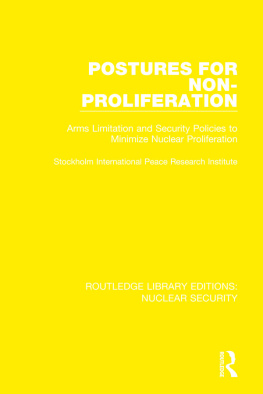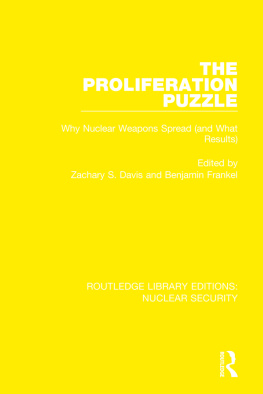Strengthening Nuclear Nonproliferation
First published 1993 by Westview Press
Published 2019 by Routledge
52 Vanderbilt Avenue, New York, NY 10017
2 Park Square, Milton Park, Abingdon, Oxon OX14 4RN
Routledge is an imprint of the Taylor & Francis Group, an informa business
Copyright 1993 Taylor & Francis
All rights reserved. No part of this book may be reprinted or reproduced or utilised in any form or by any electronic, mechanical, or other means, now known or hereafter invented, including photocopying and recording, or in any information storage or retrieval system, without permission in writing from the publishers.
Notice:
Product or corporate names may be trademarks or registered trademarks, and are used only for identification and explanation without intent to infringe.
Library of Congress Cataloging-in-Publication Data
Bailey, Kathleen C.
Strengthening nuclear nonproliferation / Kathleen C. Bailey.
p.cm.
Includes bibliographical references and index.
1. Nuclear nonproliferation.I. Title.
JX1974.73.B35 1993
327.174dc20
93-29169
CIP
ISBN 13: 978-0-367-28895-2 (hbk)
For my father, Angus Brown Bailey
I gratefully acknowledge support for this project from Lawrence Livermore National Laboratory, the United States Institute of Peace, and the National Institute for Public Policy. The opinions, findings, and conclusions or recommendations expressed in this book are mine and do not necessarily reflect the views of the United States Government or any of the abovementioned institutions.
Many people shared their time and thoughts with me. I am indebted to the twelve experts from the International Atomic Energy Agency who briefed me on safeguards issues and to Bob Barker for taking notes and participating in the interviews.
I would like to thank several people who commented on one or more chapters: Paul Brown, Bill Domke, Bill Dunlop, Frank Houck, Joe Indusi, Neil Joeck, Steve Lambakis, Peter Lavoy, Ron Lehman, George Miller, George Moussalli, Ellen Raber, Amy Sands, Robin Staffin, Jessica Stem, Bill Sutcliff, Roland Timerbaev, and Pierre Villaros. Kristie Monica helped with typing and dozens of details. Also, Steve Petersons and Ginny Baldwins editing and manuscript preparation are much appreciated.
I am especially grateful to those who reviewed major portions or all of the manuscript, giving me extensive suggestions and corrections. They are George Anzelon, Paul Chrzanowski, David Fischer, Jerry Mullins, and John Simpson. The opinions expressed and any errors that these people may have missed are my own.
Kathleen C. Bailey
1
Introduction
The nuclear nonproliferation regime is a set of policies and political commitments designed since the 1960s to prevent the further spread of nuclear weapons and, to the extent possible, roll back weapons programs and pursue disarmament. The key components of the regime are treaties (both the 1968 Nuclear Nonproliferation Treaty and regional agreements), export controls (particularly the Nuclear Suppliers Group), safeguards, and bilateral and multilateral initiatives. An example of the latter is the set of UN Security Council Resolutions passed in 1991 mandating the identification and destruction of Iraqs programs for weapons of mass destruction and their delivery systems.
Since 1990, events have shown thatnuclear proliferation remains a threat to world stability and security. The nuclear nonproliferation regime failed to deter or detect the Iraqi nuclear weapons program. The dissolution of the Soviet Union has created four states in possession of nuclear weapons, at least two of which have signaled intent to retain weapons status. Iran and North Korea are suspected of pursuing nuclear weapons capability, although both are party to the NPT and deny nuclear ambitions. Former Soviet nuclear weapons are being dismantled; Russia continues spent-fuel re-processing; Japan, India, and perhaps others are amassing plutonium; Pakistan chums out enriched uranium. These activities all create an increasing pool of special nuclear materials which could be sold on the black market or stolen by terrorists. Such events pose serious challenges to the nuclear nonproliferation regime.
This book examines the components of the nuclear nonproliferation regime and policies which have been suggested as means to strengthen it. The purpose is to stimulate discussion of alternatives that might lower the likelihood of further proliferation and help reduce the nuclear arms and capabilities of prolifrant states.
2
The Nuclear Nonproliferation Treaty: Purpose and Performance
Nuclear nonproliferation treaties are legal documents that provide a means for nations to make a political commitment to refrain from acquiring nuclear weapons. The Treaty of Tlatelolco and the Treaty of Rarotonga are regional treaties establishing nuclear-weapons-free zones in Latin America and the South Pacific, respectively. The Nuclear Nonproliferation Treaty (NPT)upon which this chapter focuses is a multilateral treaty open to membership worldwide, and has over 150 states party. These treaties cannot prevent a nation, whether a member or nonmember, from acquiring nuclear weapons if it wishes to do so. The treaties do not contain provisions for punishment of nations that choose to acquire weapons. Despite these weaknesses, the treaties have played a strong role in international nuclear nonproliferation policy. In particular, the NPT has been the basis for international discussion regarding nuclear nonproliferation and has codified norms against the spread of nuclear weapons. It has also provided a framework for NPT-type safeguards (discussed in ) and export controls.
Because the NPT is international in scope and its norms are so widely accepted, its future is entwined in the acceptance and viability of nuclear nonproliferation as a global goal. In 1995, a conference of treaty members will meet to determine the length of time that the NPT will be extended. In a sense, the parties will be judging the performance and contribution of the NPT to the security of individual nations and the world community. This chapter reviews the purpose, weaknesses, and effectiveness of the NPT.
The Nuclear Nonproliferation Treaty (NPT) entered into force in 1970. It was established to help end the nuclear arms race and prevent the further spread of nuclear weapons. At the time the treaty was opened for signature in 1968, there were five existing nuclear weapons states. The United States had detonated a nuclear device in 1945; the Soviet Union, 1949; the United Kingdom, 1952; France, 1960; and China, 1964. The intent of the treaty was to stop the number at five and to commit those five to work toward disarmament. Essentially, the long-range vision of the treatys drafters was a nuclear-weapons-free world.
To stop the number of nuclear weapons states at five, at least three major issues needed to be addressed at the outset. One was placing controls on the then rapidly expanding number of civil nuclear power programs worldwide. Civil nuclear fuel cycles can be used to generate special nuclear materials usable in explosives. Framers of the treaty sought to construct political and technical barriers to using civil nuclear industries for nonpeaceful purposes. Safeguardsinspections and monitoring of nuclear materials and facilities by an international agencywere the mainstay of the system, which was designed to prevent use of commercial and research programs for nonpeaceful purposes.

